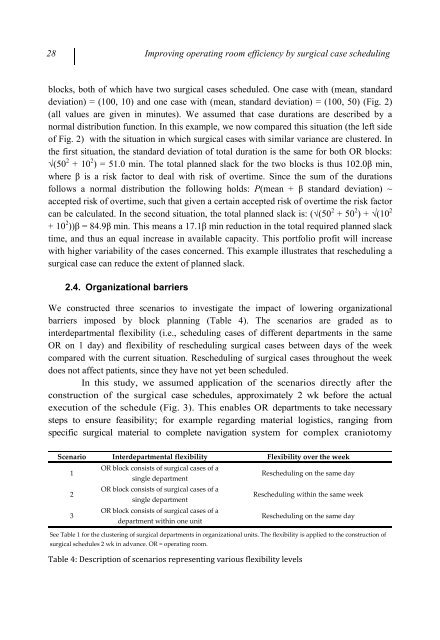Applying mathematical models to surgical patient planning
Applying mathematical models to surgical patient planning
Applying mathematical models to surgical patient planning
You also want an ePaper? Increase the reach of your titles
YUMPU automatically turns print PDFs into web optimized ePapers that Google loves.
28 Improving operating room efficiency by <strong>surgical</strong> case scheduling<br />
blocks, both of which have two <strong>surgical</strong> cases scheduled. One case with (mean, standard<br />
deviation) = (100, 10) and one case with (mean, standard deviation) = (100, 50) (Fig. 2)<br />
(all values are given in minutes). We assumed that case durations are described by a<br />
normal distribution function. In this example, we now compared this situation (the left side<br />
of Fig. 2) with the situation in which <strong>surgical</strong> cases with similar variance are clustered. In<br />
the first situation, the standard deviation of <strong>to</strong>tal duration is the same for both OR blocks:<br />
√(50 2 + 10 2 ) = 51.0 min. The <strong>to</strong>tal planned slack for the two blocks is thus 102.0β min,<br />
where β is a risk fac<strong>to</strong>r <strong>to</strong> deal with risk of overtime. Since the sum of the durations<br />
follows a normal distribution the following holds: P(mean + β standard deviation) ~<br />
accepted risk of overtime, such that given a certain accepted risk of overtime the risk fac<strong>to</strong>r<br />
can be calculated. In the second situation, the <strong>to</strong>tal planned slack is: (√(50 2 + 50 2 ) + √(10 2<br />
+ 10 2 ))β = 84.9β min. This means a 17.1β min reduction in the <strong>to</strong>tal required planned slack<br />
time, and thus an equal increase in available capacity. This portfolio profit will increase<br />
with higher variability of the cases concerned. This example illustrates that rescheduling a<br />
<strong>surgical</strong> case can reduce the extent of planned slack.<br />
2.4. Organizational barriers<br />
We constructed three scenarios <strong>to</strong> investigate the impact of lowering organizational<br />
barriers imposed by block <strong>planning</strong> (Table 4). The scenarios are graded as <strong>to</strong><br />
interdepartmental flexibility (i.e., scheduling cases of different departments in the same<br />
OR on 1 day) and flexibility of rescheduling <strong>surgical</strong> cases between days of the week<br />
compared with the current situation. Rescheduling of <strong>surgical</strong> cases throughout the week<br />
does not affect <strong>patient</strong>s, since they have not yet been scheduled.<br />
In this study, we assumed application of the scenarios directly after the<br />
construction of the <strong>surgical</strong> case schedules, approximately 2 wk before the actual<br />
execution of the schedule (Fig. 3). This enables OR departments <strong>to</strong> take necessary<br />
steps <strong>to</strong> ensure feasibility; for example regarding material logistics, ranging from<br />
specific <strong>surgical</strong> material <strong>to</strong> complete navigation system for complex cranio<strong>to</strong>my<br />
Scenario Interdepartmental flexibility Flexibility over the week<br />
1<br />
2<br />
3<br />
OR block consists of <strong>surgical</strong> cases of a<br />
single department<br />
OR block consists of <strong>surgical</strong> cases of a<br />
single department<br />
OR block consists of <strong>surgical</strong> cases of a<br />
department within one unit<br />
Rescheduling on the same day<br />
Rescheduling within the same week<br />
Rescheduling on the same day<br />
See Table 1 for the clustering of <strong>surgical</strong> departments in organizational units. The flexibility is applied <strong>to</strong> the construction of<br />
<strong>surgical</strong> schedules 2 wk in advance. OR = operating room.<br />
Table 4: Description of scenarios representing various flexibility levels

















